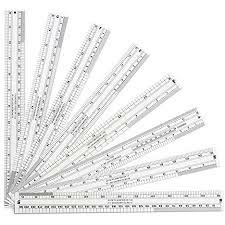Drawing Instruments:
The Instruments and other aids used in draughting work are listed below:
- Drawing board
- Mini draughter
- Instrument box
- Set squares
- Protractor
- Set of scales
- French curves
- Drawing sheets
- Pencils
- Templates
Drawing Board:
Until recently drawing boards used are made of well seasoned softwood of about 25 mm thick with a working edge for T-square. Nowadays, mini draughter are used instead of T-Square that can be fixed on any board. The size of the board depends on the size of the drawing sheet size.

|
| figure: Drawing Board with mini-draughter |
Mini-Draughter:
The mini-drawer consists of two hand-drawn angles whose scales are marked and tightly connected to each other. It combines the functions of T-square, set-square, scale and protractor. It is used to draw horizontal, vertical and inclined lines, parallel and vertical lines and to measure lines and angles.

|
| source: amazon.com |
Instrument Box:
Instrument box contains:
- Compasses
- Dividers
- Inking pens.

|
| | figure: Sharpening and position of compass lead |
figure: Sharpening and position of compass lead
The position of the pencil lead is important with respect to the tip of the compass. It should be at least 1 mm as shown in the figure, as the tip goes into the board to catch 1 mm.

|
| figure: Position of the lead leg to draw larger circles |
Set of Scales:
Scales are used to draw objects according to the desired size of the scale. These are made of wood, steel or plastic. BIS recommends eight set-scale in plastic / cardboard with designations like MI, M2 etc. as shown In the table (set of scales)
|
Scale on one edge |
Scale on other edge |
| M1 |
1:1 |
1:2 |
| M2 |
1:2.5 |
1:5 |
| M3 |
1:10 |
1:20 |
| M4 |
1:50 |
1:100 |
| M5 |
1:200 |
1:500 |
| M6 |
1:300 |
1:600 |
| M7 |
1:400 |
1:800 |
| M8 |
1:1000 |
1:2000 |
Table:Set of Scales
Do not use scales as straight edges to draw straight lines.
These are used to draw irregular curved lines in addition to circles or arches of circles.
| Category |
Recommended scales |
| Enlargement scales |
50:1 |
20:1 |
10:1 |
|
5:1 |
2:1 |
|
| Full size |
1:1 |
|
|
| Reduction scales |
1:2 |
1:5 |
1:10 |
|
1:20 |
1:50 |
1:100 |
|
1:200 |
1:500 |
1:1000 |
|
1:2000 |
1:5000 |
1:10000 |
Table: Scales for use on technical drawings (IS: 46-1988)
French Curves:
French curves are available in different sizes. First a series of points is drawn on the desired path and then the most appropriate curve is drawn on the edge of the curve. The elastic curve has a lead bar inside the rubber that bends conveniently to draw a smooth curve through a set of points.








